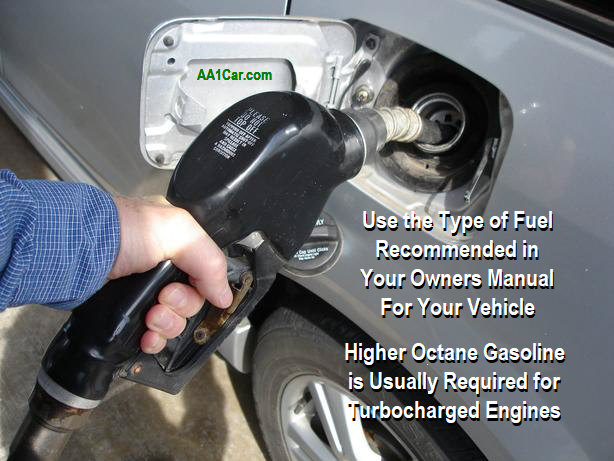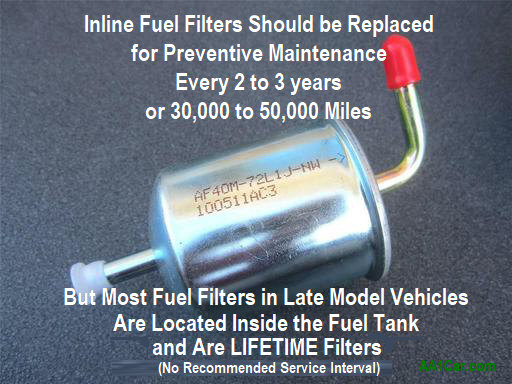
Home, Auto Repair Library, Auto Parts, Accessories, Tools, Manuals & Books, Car BLOG, Links, Index
Fuel System: Frequently Asked Questions
by Larry Carley copyright AA1Car.com



When you fill your fuel tank, it is important to make sure the gas cap is replaced and tight afterwards so there are no fuel vapor leaks. Some gas caps click when they are fully tight, but some may require the cap to be turned until it clicks several times to be fully closed.
If you forgot to replace the gas cap after filling up, or the cap was not fully tightened, it can leak fuel vapor. Your vehicle has an "Evaporative Emission Control System" (EVAP) that will detect even a tiny leak if the gas cap is loose, missing or not sealing properly. The EVAP system will run a leak check at some point after filling up, and if it detects a leak it will turn on the Check Engine light and set a fault code.
The code can be read with a scan tool.
A code P0455 indicates a large fuel vapor leak (loose or missing gas cap or leaky fuel tank vapor hose).
A code P0457 is typical for a loose gas cap.
A small pinhole-sized leak in a vapor hose, or a leaky gas cap gasket will set a code P0456.
For more information see Is Your Gas Cap Loose?
Most fuel pumps should last upwards of 100,000 miles or more with no problems. But sometimes a fuel pump will just suddenly die with no warning whatsoever. The underlying fault may be electrical (bad pump motor, electrical relay or a wiring fault), or in the case of a high mileage pump worn shaft bearings or damage to the pump impeller or gears.
A dead Fuel Pump will not deliver any fuel to the engine, preventing the engine from starting or running. The fix is to replace the fuel pump.
For more information on this kind of problem, see How to Diagnose a Bad Fuel Pump and How To Replace an In-Tank Electric Fuel Pump.
A Clogged Fuel Filter will restrict fuel flow from the fuel pump to the engine, causing a loss of fuel pressure, poor performance, possible stalling or rough running or hard starting, or not starting at all.
On older vehicles, the fuel filter was typically located somewhere in the fuel line between the fuel tank and engine, allowing it to be easily replaced if it was clogged. Replacing the filter every 30,000 or so miles for preventive maintenance was also recommended. But on most late model vehicles, the fuel filter is part of the fuel pump module assembly INSIDE the fuel tank, making it difficult to access and replace.
In-tank fuel filters typically have a high capacity for dirt and debris, and should last over 100,000 miles without clogging. But if dirt or sediment gets inside the fuel tank, it may plug up the fuel filter and/or the fuel pump inlet screen, creating a restriction.
Testing fuel pressure and volume will tell you whether or not the filter is clogged and needs to be replaced.
Dirty Fuel Injectors are typically the result of fuel varnish deposits building up inside the injector nozzles. This can be the result of frequent short trip stop-and-go driving, and/or using gasoline that does not contain adequate levels of detergent to keep the injectors clean.
Buying gasoline that meets Top Tier standards can protect against fuel varnish buildup in your engine's fuel injectors. Using some type of Fuel System Cleaner can also help keep your injectors clean.
If a set of injectors is really dirty and fails to respond to a fuel tank cleaner additive, they may have to be professionally cleaned on or off-the engine, or replaced with new injectors if the original injectors cannot be cleaned adequately.
A Dirty Throttle Body can affect idle quality and throttle response. Fuel varnish vapors can form a layer of varnish inside the throttle body that interferes with air flow into the engine. Using a throttle body cleaner can remove these deposits and restore normal operation.
Fuel Leaks are extremely dangerous because of the fire hazard they may create, and should be investigated and repair without delay!
Fuel leaks can occur anywhere in the fuel system from the fuel tank, fuel lines, an inline fuel filter (if used), hoses, the fuel injector supply rail or at the injector connections.
The fuel pressure inside the fuel lines on most late model engines can range from 30 to 85 PSI or more, so it doesn't take much of a leak to create a dangerous situation.
If you smell gasoline in the vicinity of your parked car, check underneath your vehicle for fuel dripping or puddles. Also check under the hood for any signs of fuel leaks (set spots or fuel puddling on the top of the engine). If you find a leak, DO NOT start your engine. Your vehicle needs to be repaired ASAP, which may require having it towed to a repair shop to get it fixed.
If you are driving and smell gasoline, STOP ASAP, shut the engine off and check underneath and under the hood for any fuel leaks. As before, if you see a leak, DO NOT restart the engine or drive your vehicle. Get it towed to a repair shop for repairs.
NEVER smoke around an engine that has a known fuel leak, and do not use any type of electrical equipment or tools that generate a spark.
If an engine is running and a fuel leak allows fuel to spray out on a hot exhaust manifold or exhaust pipe, it can ignite and cause a serious fire. If you have a fire extinguisher that is rated CLASS B for flammable liquids, you may be able to put a small fire out. But the best advice is get away from the vehicle, call the fire department and let them deal with it as any type of vehicle fire can be extremely dangerous!


If you drive a gasoline-powered vehicle, and it is NOT a FLEX FUEL rated vehicle, you should use unleaded regular, mid-grade or premium fuel depending on the vehicle manufacturer recommendations. As a rule, most turbocharged and supercharged engines recommend a higher octane premium grade fuel for maximum performance. Most naturally-aspirated engines that are not turbocharged or supercharged can use unleaded regular grade gasoline.
Filling your tank with PREMIUM if it only required regular will not hurt anything, but it won't boost performance. You might get slightly better fuel mileage but it might not be worth the extra cost of the premium fuel.
High ethanol alcohol blends such as E85 are for use in FLEX FUEL rated vehicles only. E85 requires much richer fuel mixture to run properly, so putting it in a vehicle that is not FLEX FUEL compatible will cause the engine to run poorly. Filling the entire tank with E85 in a non FLEX FUEL vehicle will cause noticeable problems in engine performance, but adding only a few gallons to a tank that already contains maybe a quarter to half a tank of unleaded regular may not cause any noticeable issues.
If your vehicle is rated for E85 FLEX FUEL, it will usually have a YELLOW gas cap.
You can put unleaded regular gasoline in a FLEX FUEL vehicle, but you should not put E85 into a vehicle that is not designed to handle E85.
It's unlikely to mistakenly add diesel fuel to a gasoline fuel tank because of the different size of the fuel filler nozzles. If it does somehow happen, don't start or drive the vehicle. The tank should be drained and refilled with gasoline.
The same goes for putting gasoline into a diesel truck. If that happens, don't start the engine or drive your vehicle. Drain the tank and replace with diesel fuel. If you didn't realize the mistake and started your diesel engine, gasoline can damage the high pressure fuel injection pump. The entire fuel system will have to be flushed and inspected for possible damage.
For more information on accidental fuel contamination, see What To Do If You Contaminate the Fuel in your Car.

Most late model vehicles have a "lifetime" fuel filter that is part of the fuel pump module assembly inside the fuel tank. As such, there is no recommended replacement interval on most applications. Check your owners manual maintenance schedule to make sure.
Sometimes a lifetime fuel filter can become clogged if the fuel tank is contaminated with dirt or other debris. In this case, you have to change the filter. On some applications, the filter can be replaced separately from the fuel pump module, but on most it is a part of the module assembly which means an expensive repair because you have to replace the whole unit. In either case, you will usually have to drop the fuel tank to access and change the fuel pump module.
On older (mostly 1990s & older vehicles), most fuel systems had a simple in-line fuel filter located somewhere between the fuel tank and engine in the fuel supply line. Your owners manual should show you the location of the filter and the recommended service interval. On these older cars, REPLACING THE FUEL FILTERevery 2 or 3 years or 30,000 to 50,000 miles is typically recommended.
NOTE: Changing a fuel filter with quick lock push together couplings (not old fashioned clamps) requires a special quick release tool to separate the fuel lines from the filter. If you attempt to pull or pry the fuel line connections apart without first releasing the internal quick lock coupling, you will damage the lines.

Running your fuel tank empty may damage your fuel pump because the pump relies on a steady supply of fuel for both cooling and lubrication.
If you have run your tank dry, poured some gas back in the tank and then discovered your engine won't start, guess what? You probably killed your fuel pump.
The fix is to replace the fuel pump. And next time, don't forget to fill your tank before the fuel gauge reads EMPTY! In fact, to reduce the risk of a repeat fuel pump failure, don't let your fuel gauge drop below a quarter of a tank.
 Related Articles:
Related Articles: Click Here to See More Carley Automotive Technical Articles
Click Here to See More Carley Automotive Technical Articles